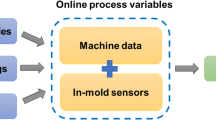Abstract
Plastic injection moulding is a typical complex manufacturing process. Its product quality is difficult to assure because of the nonuniform material shrinkage. This research introduces a prognostic concept for predicting the product quality (four edge shrinkages). The prognostic model is developed by path analysis through LISREL which can define the model’s reliability when only few sensory data are retrieved from the smoothly running system. The prognostic model is validated by 25 test runs. In each run, each of the nine manufacturing conditions is randomly set at the extreme limit, i.e., either the lower limit or the upper limit. By comparing the actual edge shrinkages defined by the finite element software Moldflow with the results predicted by the prognostic model, this research concludes the prognostic model can successfully predict the quality of products and prevent the production of defective products.






Similar content being viewed by others

References
Dong M, He D (2007) Hidden semi-Markov model-based methodology for multi-sensor equipment health diagnosis and prognosis. Eur J Oper Res 178:858–878
Chinnam RB, Baruah P (2008) Autonomous diagnostics and prognostics in machining processes through competitive learning-driven HMM-based clustering. Int J Prod Res 47:6739–6758
Roemer MJ, Kacprzynski GJ, Schoeller MH (2001) Improved diagnostic and prognostic assessments using health management information fusion. In: AUTOTESTCON proceedings, 2001. IEEE systems readiness technology conference. pp 365–377
Engel SJ, Gilmartin BJ, Bongort K, Hess A (2000) Prognostics, the real issues involved with predicting life remaining. In: Aerospace conference proceedings, 2000 IEEE. vol. 456, pp 457–469
Hardman W, Hess A, Blunt D (2001) A USN development strategy and demonstration results for propulsion and mechanical systems diagnostics, prognostics and health management. In: Aerospace conference, 2001, IEEE proceedings, vol. 3056, pp 3059–3068
Dong M, He D, Banerjee P, Keller J (2006) Equipment health diagnosis and prognosis using hidden semi-Markov models. Int J Adv Manuf Technol 30:738–749
Winkler H, Heins M, Nyhuis P (2007) A controlling system based on cause–effect relationships for the ramp-up of production systems. Prod Eng 1:103–111
Liao SJ, Chang DY, Chen HJ, Tsou LS, Ho JR, Yau HT, Hsieh WH, Wang JT, Su YC (2004) Optimal process conditions of shrinkage and warpage of thin-wall parts. Polym Eng Sci 44:917–928
Chiang KT, Chang FP (2007) Analysis of shrinkage and warpage in an injection-molded part with a thin shell feature using the response surface methodology. Int J Adv Manuf Technol 35:468–479
Mok SL, Kwong CK (2002) Application of artificial neural network and fuzzy logic in a case-based system for initial process parameter setting of injection molding. J Intell Manuf 13:165–176
Kurtaran H, Ozcelik B, Erzurumlu T (2005) Warpage optimization of a bus ceiling lamp base using neural network model and genetic algorithm. J Mater Process Technol 169:314–319
Liao SJ, Hsieh WH, Wang JT, Su YC (2004) Shrinkage and warpage prediction of injection-molded thin-wall parts using artificial neural networks. Polym Eng Sci 44:2029–2040
He W, Zhang YF, Lee KS, Fuh JYH, Nee AYC (1998) Automated process parameter resetting for injection moulding: a fuzzy-neuro approach. J Intell Manuf 9:17–27
Ozcelik B, Erzurumlu T (2006) Comparison of the warpage optimization in the plastic injection molding using ANOVA, neural network model and genetic algorithm. J Mater Process Technol 171:437–445
Huang MC, Tai CC (2001) The effective factors in the warpage problem of an injection-molded part with a thin shell feature. J Mater Process Technol 110:1–9
Kurtaran H, Erzurumlu T (2006) Efficient warpage optimization of thin shell plastic parts using response surface methodology and genetic algorithm. Int J Adv Manuf Technol 27:468–472
Ozcelik B, Erzurumlu T (2005) Determination of effecting dimensional parameters on warpage of thin shell plastic parts using integrated response surface method and genetic algorithmic. Int Commun Heat Mass Transf 32:1085–1094
Chen W-L, Huang C-Y, Hung C-W (2010) Optimization of plastic injection molding process by dual response surface method with non-linear programming. Engineering computations 27: to appear
Chen ZB, Turng LS (2005) A review of current developments in process and quality control for injection molding. Adv Polym Technol 24:165–182
Heim HP (2002) The statistical regression calculation in plastics processing—Process analysis, optimization and monitoring. Macromol Mater Eng 287:773–783
Autodesk (2009) Autodesk moldflow insight. http://usa.autodesk.com/adsk/servlet/index?siteID=123112&id=13195432. Accessed 15 July 2009
Walsh SF (1993) Shrinkage and warpage prediction for injection-molded components. J Reinf Plast Compos 12:769–777
MoldFlow (2006) MoldFlow plastic insight release 6.0
Jeoreskog KG, Seorbom D (1996) LISREL 8: User’s reference guide scientific software international, Chicago, IL
Raykov T, Marcoulides GA (2006) A first course in structural equation modeling. Lawrence Erlbaum Associates, Mahwah
Browne MW, Cudeck R (1993) Alternative ways of assessing model fit. In: Bollen KA, Long JS (eds) Testing structural equation models. SAGE Publications, Newbury Park, CA, pp 445–455
Byrne BM (2001) Structural equation modeling with AMOS: basic concepts, applications, and programming. Lawrence Erlbaum Associates, Mahwah
Gatignon H (2003) Statistical analysis of management data. Kluwer Academic Publishers, Boston
Hu L, Bentler PM (1999) Cutoff criteria for fit indexes in covariance structure analysis: conventional criteria versus new alternatives. Struct Equ Modeling 6:1–55
Carvounis CP (2000) Handbook of biostatistics: a review and text. Parthenon Pub. Group, New York
Ertunc HM, Loparo KA (2001) A decision fusion algorithm for tool wear condition monitoring in drilling. Int J Mach Tools Manuf 41:1347–1362
Baruah P, Chinnam RB (2005) HMMs for diagnostics and prognostics in machining processes. Int J Prod Res 43:1275–1293
Acknowledgments
The authors would like to thank Moldflow Corporation in Taiwan for the permission to use the plastic part been analyzed in this research. Special thanks to the financial support from the research projects 96-2221-E-029-024 and 98-2221-E-029-019, National Science Council of Taiwan. The authors are grateful to the expert anonymous reviewers whose comments and suggestions considerably improved this article.
Author information
Authors and Affiliations
Corresponding author
Rights and permissions
About this article
Cite this article
Huang, CY., Chen, WL., Cheng, CM. et al. Product quality prognosis in plastic injection moulding. Prod. Eng. Res. Devel. 5, 59–71 (2011). https://doi.org/10.1007/s11740-010-0269-7
Received:
Accepted:
Published:
Issue Date:
DOI: https://doi.org/10.1007/s11740-010-0269-7



